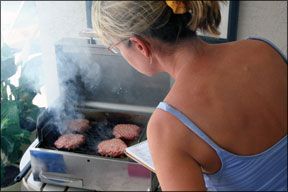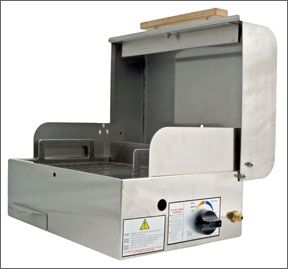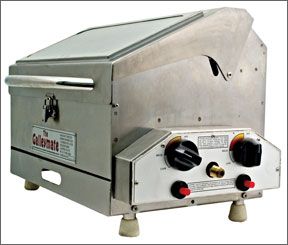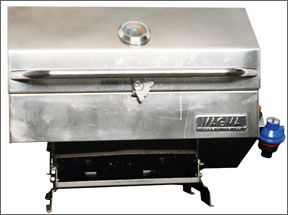In our June 2006 issue, we looked at six propane marine barbecue grills from four makers. The Magma Catalina was rated our Best Choice and the Force 10 Sea Grill earned our Budget Buy. Since that test, two grills from Australia were brought to our attention: the Sovereign Bravo BBQ and the Galleymate 1100.
In this test, we compared the grills from Down Under to each other, and pitted them against the winner of our previous test, the Magma Catalina. We should note that the Catalina was the most expensive grill in the previous test, with a price tag of $300. The Sovereign ($650) and the Galleymate ($799) are substantially more expensive. (No, those are not Australian dollars.)
Like the grills in our previous test, both of these are designed specifically for use on boats. They both feature roll-back lids and polished stainless-steel finishes. But several features unique to these two Aussie grills stood out. Both grills have an optional grill face that is part grill and part flat plate, or griddle. The grill faces are substantial-machined from large sheets of corrosion-resistant steel, as opposed to the welded wire-frame grill in the Catalina and other grills in the previous test. Both the Galleymate and Sovereign offer excellent wind protection. And both come with an impressively large range of both rail and deck mountings that testers found to be quick and easy to install. Finally, both are made from grade 316, 1/16-inch-thick stainless steel-thats twice as beefy as the Catalina, which is made of less-expensive 304 grade stainless.

Sovereign Bravo
Sovereign BBQs & Grills Australia makes two grills: the Alpha (large) and Bravo (small). Both models are available with either a flat/grill plate combination or a full flat plate for Australian-style cooking. U.S. importer Quickline sent Practical Sailor the Bravo flat/grill plate model for testing. The Bravo is well-constructed with a fully welded 316 stainless steel body and a stainless-steel burner. The grill body is fully TIG welded, not folded and spot welded. The Sovereigns grill plate is made from 3CR12, a chromium-containing steel that is rust resistant and has excellent thermal conductivity. The grill plate has substantial handles on both sides, allowing for easy removal for cleaning and access to the burners. A deep tray under the grill face catches grease and fat and is also easy to remove for cleaning.

Practical Sailor found that it took more than a couple of attempts to master the grills piezo igniter. One reason lighting is a bit tricky is that the grill is equipped with a thermocouple (flame-failure safety device). In the event that the flame blows out, the safety device automatically cuts off gas flow at the burner within five to 10 seconds. Although flame-failure devices are standard on most propane-burning galley stoves, this is the only grill that we have tested with one.
There is no thermometer or any visual temperature indicator. The grill has a baffled air intake, reducing the chances of the flame blowing out in high winds. It has wind guards and an oversized splash panel in the back to minimize fat splattering into the rear vent.
There is an adjustable steam vent on top of the lid to allow heat to escape. The body has a double-skinned base compartment, which reduces heat transfer to the grill exterior. A teak handle at the front of the grill adds a nice nautical touch. The locking latch is a simple thumbscrew.
The Bravo has the smallest cooking area of the three grills compared here. When testers spread the pizza dough across the face of the grill for the heat-distribution test (see “How We Tested,” above), two consistent hot spots, one small square in the left rear and one small square in the left front, were evident. We found no hot spots on the griddle part of the grill. With the exception of the two spots, the dough cooked fairly evenly. When we added the fatty, frozen hamburgers, a significant flame-up required a water spritz.
A warning on the side of the grill says to always use a low setting when cooking with the lid closed. The burners are rated at 10,500 BTU, and with a solid grill plate, the heat builds up fast. The manual notes that the barbecue is designed to generate the required additional heat in adverse conditions such as wind and rain but that in general, a low setting is optimum for cooking.
In the burger test, testers actually preferred the taste of the griddle-side burgers. Perhaps Americans have a thing or two to learn from a country that is as fanatical about barbecuing as we are.

The Sovereign offers a handful of mounting options on both the deck and the rail. The deck-mount choices include slot mounts in the front of the grill and recessed mounts in the front, center, and rear. The rail mounts can be positioned at the front, center, or rear of the grill. A telescopic rod can be used to add support. The grill comes nearly assembled and is easy to clean.
Bottom Line:
The Sovereign cuts no corners when it comes to construction. Its heavy-duty body combined with its small cooking area fills an interesting niche. With the griddle, its almost like having a second stove. The flame-failure device, piezo ignition system, heavy-gauge stainless steel, and array of mounting options all make for a top-quality grill. You get what you pay for here.
Galleymate 1100
Distributed in the U.S. by Fourwinds (www.fourwinds-ii.com) and Marine Fisheries Supply (www.fisheriessupply.com), the Galleymate 1100 quickly caught testers attention. Two standout features were the grills glass window and its twin burners, which were not found in any of the grills in our previous test. The glass window on the grill lid allows you to cook under severe weather conditions and still keep an eye on your chops. Cooking with the lid closed also keeps grease splatters from the front of the grill off the deck.
With 20,000 BTUs available from this small grill, keeping the heat under control may be a challenge. Comparatively, Force 10s Sea Grill offered the highest BTU rating in our previous test, at 14,000 BTUs, and we found it was hard to keep that grills heat under control. The Galleymates twin burners do offer better heat control than a single burner would; when the grill gets too hot, one side can be completely turned off. The Galleymate manual suggests setting the burners on low, under normal operating conditions. A note on the grill side advises keeping the grill temperature settings on low when the lid is closed. “Medium” and “high” setting choices may be needed only under windy or wet conditions.
The Galleymates 5.5-inch-high side wind guards taper down to 3 inches at the front of the grill. They are substantially taller than the wind guards on any of the

grills from the first round of testing and support the claim that one could cook on the Galleymate in just about any weather conditions. The Galleymate comes with an upper warming rack. A rottisserie-style spit is an option. Legs for stand-alone cooking ashore are also available. (We don’t recommend using these aboard.)
The grill has a piezo lighting system. Although testers found that it does light quickly and easily, one drawback they noted was that it was hard to tell whether the grill was lit. While they found no hot spots on the grill, they did find that when both burners were on the same setting, the left side had a tendency to get hotter than the right side and to cook faster. Along with the pizza dough and the hamburgers, testers tossed some vegetables, fish, and shrimp on this barbie. Everything had a tendency to cook very quickly. We suggest keeping the temperature on low.
The Galleymate grill body is made of 316 stainless steel, and the burners are also heavy-gauge stainless. The grill cooking surface is a rust-resistant, high-chromium stainless steel. There is a non-spill fat catchment system under the grills to collect drippings and prevent any spills onto the deck. The grill weighs 33 pounds-almost 10 pounds heavier than the heaviest grill in our previous test. Its 230-square-inch (including top rack) cooking area is larger than all grills in the previous test. The manufacturer offers a 10-year limited warranty.
Like the Sovereign, the Galleymate is easy to assemble and easy to clean. It also comes with an impressive selection of mounting options, including rail mounts and flush deck mounts. The rail mounts use a mounting bracket with spring-loaded locking pins. These pins and brackets are easy to engage and remove for storage. Anyone who has tackled a kettle barbecue hanging over the aft rail with an adjustable wrench will appreciate this.
Bottom Line:
The Galleymate is a top-of-the-line grill that performed well in all tests. The two burners and the glass window are unique to all stoves we tested, as is its 20,000 BTUs. Keep an eye on your food and, barring a tropical storm, keep the temperature settings on low. This is a heavy-duty, well-made, well-designed grill that is easy to assembly and comes with an impressive range of mounting choices. A 10-year limited warranty is a bonus, and we have no doubt it will last that long.
Conclusion
In terms of construction and performance, the Aussie grills are outstanding. The Galleymate, with its larger grilling surface, 10-year-warranty and dual burners is a cut above the Sovereign, but the Sovereign is no less rugged and has a valuable safety feature.
Each offers plusses that you wont find in the Magma Catalina. If you want superior windproofness and dual burners, the Galleymate is king of the hill. If you want an industrial strength grill with the added safety of a flame-failure device, the Sovereign can’t be beat. Both earn Practical Sailor recommendations.
Testers found only a few minor faults. The ignitor buttons and flame controls on both grills are fitted vertically on the sides, making them harder to operate and check visually while cooking. And neither grill has a temperature gauge, useful for monitoring temp with the lid closed. Over time, the position indicator line on the Galleymates flame control knob faded away-a minor, point, but something you don’t expect at this price.
Quibbles aside, these grills will likely outlast the Catalina. Although Practical Sailor minimizes price and emphasizes durability in selecting the Best Choice, the price gap is great enough here for the Catalina to hold its position as the overall favorite. It, too, is built for heavy use and has sufficient design advantages to fend off the Aussie challenge.






































